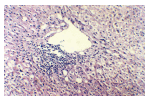Chronic Epstein-Barr virus-related hepatitis in immunocompetent patients
- PMID: 17007027
- PMCID: PMC4088175
- DOI: 10.3748/wjg.v12.i35.5711
Chronic Epstein-Barr virus-related hepatitis in immunocompetent patients
Abstract
Aim: To investigate reactivated Epstein-Barr virus (EBV) infection as a cause for chronic hepatitis.
Methods: Patients with occasionally established elevated serum aminotransferases were studied. HIV, HBV and HCV-infections were excluded as well as any other immunosuppressive factors, metabolic or toxic disorders. EBV viral capsid antigen (VCA) IgG and IgM, EA-R and EA-D IgG and Epstein-Barr nuclear antigen (EBNA) were measured using IFA kits. Immunophenotyping of whole blood was performed by multicolor flow cytometry. CD8(+) T cell responses to EBV and PHA were determined according to the intracellular expression of IFN-gamma.
Results: The mean alanine aminotransferase (ALT) and gamma glutamyl transpeptidase (GGTP) values exceeded twice the upper normal limit, AST/ALT ratio < 1. Serology tests showed reactivated EBV infection in all patients. Absolute number and percentages of T, B and NK cells were within the reference ranges. Fine subset analysis, in comparison to EBV(+) healthy carriers, revealed a significant decrease of naive T cells (P < 0.001), accompanied by increased percentage of CD45RA(-) (P < 0.0001), and terminally differentiated CD28(-)CD27(-)CD8(+) T cells (P < 0.01). Moderately elevated numbers of CD38 molecules on CD8(+) T cells (P < 0.05) proposed a low viral burden. A significantly increased percentage of CD8(+) T cells expressing IFN-gamma in response to EBV and PHA stimulation was registered in patients, as compared to controls (P < 0.05). Liver biopsy specimens from 5 patients revealed nonspecific features of low-grade hepatitis.
Conclusion: Chronic hepatitis might be a manifestation of chronic EBV infection in the lack of detectable immune deficiency; the expansion of CD28(-)CD27(-) and increase of functional EBV-specific CD8(+) T cells being the only surrogate markers of viral activity.
Figures


References
-
- Rickinson AB, Kieff E. Epsterin-Barr virus. In: Knipe DM, Howley PM, editors. Field's Virology, 4th ed, Vol.2. Philadelphia: Lippincott Williams & Wilkins; 2001. pp. 2575–2627.
-
- Cohen JI. Epstein-Barr virus infection. N Engl J Med. 2000;343:481–492. - PubMed
-
- Kimura H, Hoshino Y, Kanegane H, Tsuge I, Okamura T, Kawa K, Morishima T. Clinical and virologic characteristics of chronic active Epstein-Barr virus infection. Blood. 2001;98:280–286. - PubMed
-
- Kimura H, Morishima T, Kanegane H, Ohga S, Hoshino Y, Maeda A, Imai S, Okano M, Morio T, Yokota S, et al. Prognostic factors for chronic active Epstein-Barr virus infection. J Infect Dis. 2003;187:527–533. - PubMed
-
- Straus SE. The chronic mononucleosis syndrome. J Infect Dis. 1988;157:405–412. - PubMed
MeSH terms
Substances
LinkOut - more resources
Full Text Sources
Research Materials

